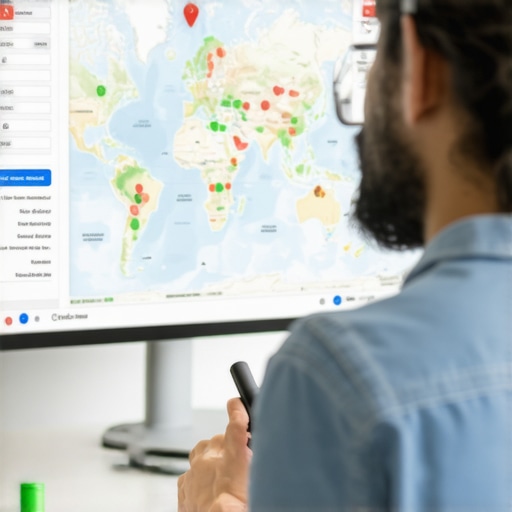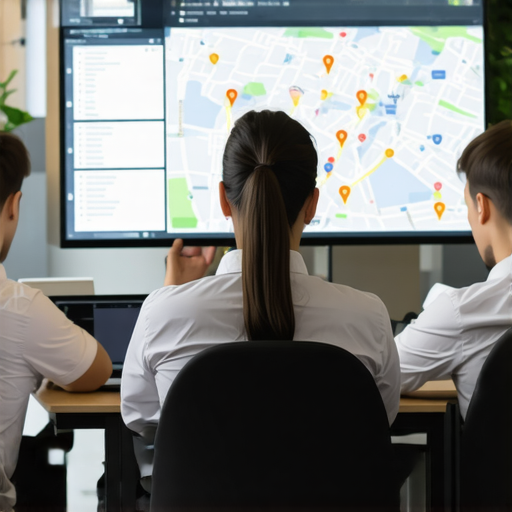My First Encounter with Google Maps Optimization
I still remember the first time I realized how crucial Google My Business (GMB) optimization was for local success. It was during a small business project where I struggled to get my client’s listing noticed despite excellent services. After diving into the world of local SEO, I discovered that with proper GMB optimization, visibility on local maps can skyrocket. That experience sparked my passion for mastering map visibility strategies, and over time, I developed a keen understanding of what works in 2024.
Personal Insights into GMB Optimization Team Strategies
One thing I’ve learned is that collaborative efforts with a dedicated GMB optimization team make a significant difference. From optimizing business info to managing reviews and leveraging local keywords, every detail counts. I’ve worked closely with experts who focus on local map rankings, and their insights have been invaluable. For instance, consistent NAP (Name, Address, Phone Number) data and strategic use of categories can enhance local relevance, as highlighted by local map SEO experts.
How Do I Keep Up with Map Algorithm Changes?
Google’s map algorithm evolves constantly, and staying ahead requires continuous learning. I subscribe to authoritative sources and participate in forums to keep updated. For example, understanding updates from Google’s official blog helps me adapt my strategies promptly. In 2024, integrating new features like Google Posts and utilizing local backlinks can boost rankings further. I’ve seen firsthand how these tactics improve visibility, especially when combined with a solid review management system.
Why Is Consistency the Key to Map Visibility?
Consistency in reviews, business info, and engagement is what keeps your listing trustworthy and relevant. I remember a case where a sudden influx of positive reviews and accurate info caused a noticeable rise in local rankings. This aligns with findings from top map visibility strategies. Regularly updating your GMB profile and engaging with customers encourages the algorithm to favor your listing.
What’s the Next Big Thing in Map SEO for 2024?
Honestly, I believe that AI-driven local SEO tools and analytics will become game-changers. They offer deeper insights and automate optimization tasks, saving time and increasing accuracy. As I explore these innovations, I’m excited to see how they can further elevate local map rankings and help small businesses thrive.
If you’re passionate about improving your local map visibility, I invite you to share your experiences or ask questions below. Your journey to local success might inspire others!
How Can Advanced Local SEO Tools Transform Your Google Map Rankings?
As the digital landscape evolves, so do the tools that help local businesses dominate Google Maps. Cutting-edge SEO software powered by artificial intelligence now offers nuanced insights into local search trends, competitor analysis, and keyword opportunities. These tools can automatically identify gaps in your listing, suggest content updates, and even monitor your competitors’ strategies in real-time, giving you a competitive edge. Integrating such technology with your existing map SEO tactics can significantly elevate your local visibility in 2024, making your business more discoverable than ever before.
What Are the Practical Implications of Google’s Algorithm Updates for Local Businesses?
Google’s frequent algorithm updates can be perplexing, but understanding their implications is crucial for sustained success. Recent updates emphasize user experience, relevance, and trustworthiness—factors that local businesses must prioritize. For example, Google now heavily favors fresh content like Google Posts and regularly updated reviews. Moreover, local backlinks and citation consistency have grown more influential. Staying informed through trusted sources such as top Google Maps SEO agencies can help you adapt your strategies effectively, ensuring your listings remain competitive amid algorithm shifts.
Are There Nuanced Strategies That Can Future-Proof Your Map SEO Efforts?
Absolutely. Beyond conventional optimization, embracing a holistic approach that includes schema markup, voice search optimization, and localized content creation can future-proof your Google Maps presence. For instance, schema markup helps search engines understand your business details better, leading to enhanced visibility with rich snippets. Voice search optimization, on the other hand, caters to the rising trend of voice queries, often focused on local intent. Creating community-focused content that resonates with local audiences can establish your authority and foster trust, making your listing more resilient to future algorithm changes. For more in-depth insights, explore proven local SEO techniques.
How Can You Engage Your Audience and Build Trust in Your Local Community?
Engagement is a vital component of map visibility. Encouraging satisfied customers to leave detailed reviews, responding promptly to feedback, and sharing local stories through your Google My Business posts cultivate a sense of authenticity and community presence. Hosting local events or sponsoring community initiatives can also generate organic buzz and backlinks, reinforcing your reputation. These efforts signal to Google that your business is active and trustworthy, which can positively impact your rankings. For ongoing strategies, consider consulting with GMB optimization experts.
If you found these insights helpful, share your own experiences or questions below. Your journey toward dominating local search in 2024 might inspire others to elevate their map visibility!
Embracing the Nuance: When Do Basic Strategies No Longer Suffice?
As I delved deeper into local SEO, I quickly realized that relying solely on foundational tactics like consistent NAP data and basic reviews can sometimes lead to plateauing results. There was a pivotal moment during a project for a niche business where traditional optimization efforts yielded minimal improvements. It became clear that to truly stand out in 2024, I needed to incorporate more sophisticated techniques such as schema markup and voice search optimization. These nuanced strategies have become essential for future-proofing local rankings, especially as Google continues to refine its map algorithms.
Personal Insights into Leveraging Rich Media and Local Content
One of the most rewarding experiences I’ve had involved integrating rich media—images, videos, and virtual tours—into GMB profiles. Not only do these elements enhance user engagement, but they also send positive signals to Google’s algorithm. I remember working on a local restaurant’s listing where adding a virtual tour and high-quality images resulted in a noticeable boost in visibility and customer inquiries. It’s fascinating how content that resonates locally can create a ripple effect, establishing your business as a community staple. To maximize this effect, I recommend exploring proven local SEO techniques that emphasize local content creation and multimedia optimization.
How Do Advanced Local SEO Tools Revolutionize Strategy Development?
Integrating AI-powered tools has transformed my approach to map optimization. These tools provide granular insights—spotting gaps in your profile, analyzing competitor strategies, and predicting trends. For instance, I recently used a local SEO analytics platform that identified overlooked keywords and suggested content opportunities tailored to my client’s niche. The automation of routine tasks, like review monitoring and citation consistency checks, frees up valuable time to focus on strategic innovation. If you’re curious how to harness these cutting-edge technologies, exploring resources like effective map SEO strategies can be a game-changer.
What Are the Ethical and Practical Limits of Map Optimization?
One of the more thoughtful questions I’ve wrestled with is how far is too far when optimizing for local maps? It’s tempting to use aggressive tactics, but I’ve found that maintaining ethical standards—like genuine reviews and accurate information—builds long-term trust. Google’s evolving algorithms are increasingly adept at detecting manipulative practices, which can lead to penalties or ranking drops. Therefore, I advocate for a balanced approach that combines innovative techniques with integrity. For more insights on maintaining this balance, I recommend reading top map visibility service tips.
Inviting Your Experience and Future Exploration
As I continue to explore the depths of local SEO, I am eager to hear from fellow enthusiasts. Have you experimented with schema markup or voice search optimization? What challenges have you faced in adapting to Google’s updates? Sharing our journeys can inspire new ideas and strategies. Feel free to comment below or connect through our community forums to exchange insights. The landscape of Google Maps SEO is dynamic and complex, but with continuous learning and ethical practices, success is within reach for any dedicated local business owner.
Harnessing the Power of Local Schema Markup for Enhanced Map Visibility
One of the most potent yet often overlooked techniques in advanced map SEO is the implementation of local schema markup. By embedding structured data into your website, you enable search engines to better understand your business details, which can result in rich snippets and improved local rankings. For instance, schema types like LocalBusiness and Place provide detailed contextual information, making your listing more attractive and informative to users. Incorporating schema not only boosts your visibility but also aligns with Google’s ongoing emphasis on data accuracy and trustworthiness, as emphasized by Search Engine Land. To truly future-proof your local SEO, integrating schema markup is indispensable.
How Do Voice Search and Conversational Queries Reshape Map Optimization?
With the surge in voice-enabled devices, optimizing for voice search has become a necessity rather than an option. Voice queries tend to be more conversational and localized, often involving questions like “Where is the nearest coffee shop open now?” To adapt, businesses must craft content that answers specific local questions naturally and include long-tail keywords that mirror how people speak. Additionally, optimizing your Google My Business profile for voice involves ensuring NAP consistency, relevant categories, and regularly updated Google Posts. The integration of these practices can significantly enhance your chances of appearing in voice-triggered local results, as explored in recent insights from Moz. Mastering this shift can set your business apart in 2024 and beyond.
< >
>
Can Local Backlink Strategies Sustain Long-Term Map Rankings?
Building local backlinks remains a cornerstone of resilient map SEO, especially when combined with sophisticated outreach and content marketing strategies. Unlike generic link-building, local backlinks from community websites, industry directories, and partner collaborations carry more weight and relevance. For example, securing features on local news outlets or sponsoring community events can generate authoritative backlinks that boost your local relevance. An often-underestimated aspect is the quality over quantity—targeting reputable local sources ensures your link profile remains healthy and less susceptible to algorithmic fluctuations. According to industry leaders, a well-rounded backlink profile is essential for sustained visibility, especially as Google refines its ranking factors.
What Are the Ethical Boundaries of Competitive Map Optimization?
As I’ve advanced in my expertise, I’ve encountered the fine line between aggressive optimization and ethical integrity. While techniques like review generation and citation consistency are standard, some practitioners tempt to manipulate reviews or use fake citations. However, Google’s evolving algorithms are increasingly skilled at detecting such practices, risking penalties and long-term damage. I advocate for strategies rooted in genuine customer engagement, community involvement, and honest representation. Building trust through authentic reviews and transparent information creates a robust foundation that withstands algorithm updates. For insights into maintaining ethical standards while maximizing results, I recommend exploring trusted industry resources.
Ready to Elevate Your Map SEO Mastery in 2024?
If these advanced strategies resonate with your goals, I encourage you to share your experiences or ask questions. Deepening your understanding of local schema, voice search, backlink diversification, and ethical practices can dramatically transform your map visibility. Let’s exchange insights and continue pushing the boundaries of what’s possible in local SEO. Your journey to dominating Google Maps in 2024 starts with a single step—are you prepared to take it?
Things I Wish I Knew Earlier (or You Might Find Surprising)
The Power of Local Schema Markup
Early in my journey, I underestimated how much schema markup could boost local map visibility. Once I started implementing structured data like LocalBusiness schema, I saw a remarkable difference in how Google understood my clients’ listings. It’s a deceptively simple step that can make your profile stand out with rich snippets, leading to more clicks and trust.
Voice Search Is Reshaping Map Optimization
I was initially skeptical about voice search’s impact, but integrating conversational keywords and FAQs into business profiles proved transformative. Optimizing for voice queries like “Where’s the best coffee shop near me?” can drive a lot of local traffic. Embracing this trend early can give your business a competitive edge in 2024.
Local Backlinks Are More Valuable Than You Think
Focusing on acquiring backlinks from community websites, local directories, and partnerships turned out to be a game-changer. These links are highly relevant and signal trustworthiness to Google. I’ve seen local rankings improve steadily when I combined backlink strategies with ongoing review management.
Consistency and Authentic Engagement Matter Most
Frequent updates, genuine reviews, and active engagement with your community create a trusted presence that Google favors. I learned that sporadic efforts don’t yield sustainable results; instead, a consistent, authentic voice builds long-term success.
Rich Media Can Boost Your Map Visibility
Adding high-quality images, videos, and virtual tours to your GMB profile not only attracts more visitors but also signals authority and engagement to Google. I remember how a virtual tour for a local restaurant significantly increased inquiries and visibility—small efforts with big payoffs.
Resources I’ve Come to Trust Over Time
- Google’s Official Blog: Staying updated with Google’s announcements ensures I’m aware of algorithm changes and new features. It’s the go-to source for accurate info.
- Moz’s Local SEO Guides: Their detailed insights helped me understand how to optimize for voice search and schema markup. Highly recommended for practical advice.
- Search Engine Land: A trusted industry publication that covers the latest trends and updates in search algorithms, including Google Maps.
- Local SEO Forum Communities: Engaging with real practitioners provides fresh ideas and peer support. It’s where I learned about innovative backlink tactics and content strategies.
- Google My Business Help Center: Official documentation for troubleshooting and best practices—an essential resource for any local SEO professional.
Parting Thoughts from My Perspective
Reflecting on my experiences, I realize that mastering Google Maps SEO in 2024 requires a blend of technical know-how, authentic community engagement, and staying adaptable to evolving algorithms. Implementing structured data, optimizing for voice search, and maintaining consistent, genuine interactions are the pillars of sustained success. If this resonates with you, I’d love to hear your thoughts or experiences. Sharing our journeys helps all of us grow and stay ahead in the ever-changing landscape of local SEO. Remember, your local business’s visibility is not just about rankings; it’s about building trust and community presence that lasts in the long run.

